1997 SSANGYONG KORANDO automatic transmission fluid
[x] Cancel search: automatic transmission fluidPage 1157 of 2053
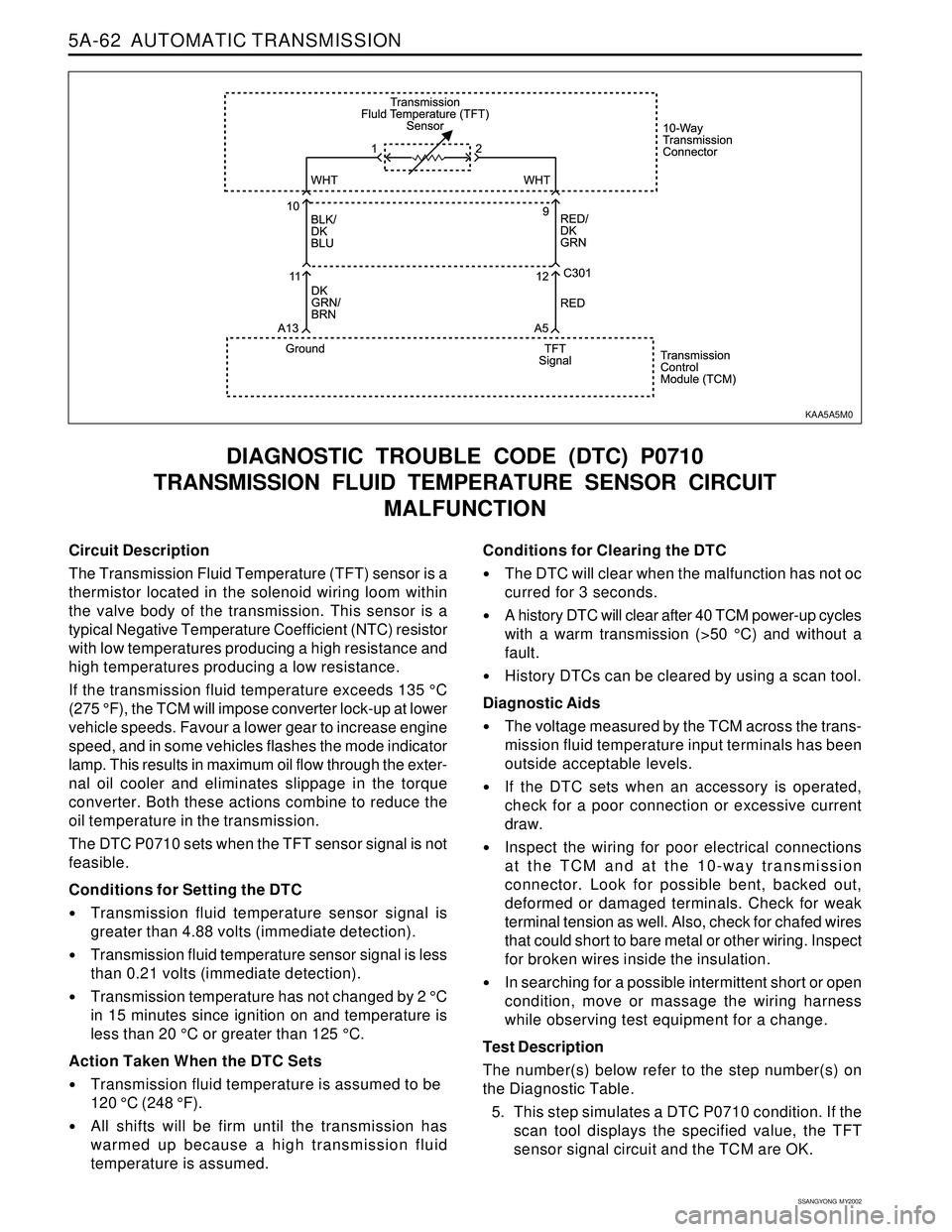
5A-62 AUTOMATIC TRANSMISSION
SSANGYONG MY2002
Circuit Description
The Transmission Fluid Temperature (TFT) sensor is a
thermistor located in the solenoid wiring loom within
the valve body of the transmission. This sensor is a
typical Negative Temperature Coefficient (NTC) resistor
with low temperatures producing a high resistance and
high temperatures producing a low resistance.
If the transmission fluid temperature exceeds 135 °C
(275 °F), the TCM will impose converter lock-up at lower
vehicle speeds. Favour a lower gear to increase engine
speed, and in some vehicles flashes the mode indicator
lamp. This results in maximum oil flow through the exter-
nal oil cooler and eliminates slippage in the torque
converter. Both these actions combine to reduce the
oil temperature in the transmission.
The DTC P0710 sets when the TFT sensor signal is not
feasible.
Conditions for Setting the DTC
Transmission fluid temperature sensor signal is
greater than 4.88 volts (immediate detection).
Transmission fluid temperature sensor signal is less
than 0.21 volts (immediate detection).
Transmission temperature has not changed by 2 °C
in 15 minutes since ignition on and temperature is
less than 20 °C or greater than 125 °C.
Action Taken When the DTC Sets
Transmission fluid temperature is assumed to be
120 °C (248 °F).
All shifts will be firm until the transmission has
warmed up because a high transmission fluid
temperature is assumed.
DIAGNOSTIC TROUBLE CODE (DTC) P0710
TRANSMISSION FLUID TEMPERATURE SENSOR CIRCUIT
MALFUNCTION
Conditions for Clearing the DTC
The DTC will clear when the malfunction has not oc
curred for 3 seconds.
A history DTC will clear after 40 TCM power-up cycles
with a warm transmission (>50 °C) and without a
fault.
History DTCs can be cleared by using a scan tool.
Diagnostic Aids
The voltage measured by the TCM across the trans-
mission fluid temperature input terminals has been
outside acceptable levels.
If the DTC sets when an accessory is operated,
check for a poor connection or excessive current
draw.
Inspect the wiring for poor electrical connections
at the TCM and at the 10-way transmission
connector. Look for possible bent, backed out,
deformed or damaged terminals. Check for weak
terminal tension as well. Also, check for chafed wires
that could short to bare metal or other wiring. Inspect
for broken wires inside the insulation.
In searching for a possible intermittent short or open
condition, move or massage the wiring harness
while observing test equipment for a change.
Test Description
The number(s) below refer to the step number(s) on
the Diagnostic Table.
5. This step simulates a DTC P0710 condition. If the
scan tool displays the specified value, the TFT
sensor signal circuit and the TCM are OK.
KAA5A5M0
Page 1158 of 2053
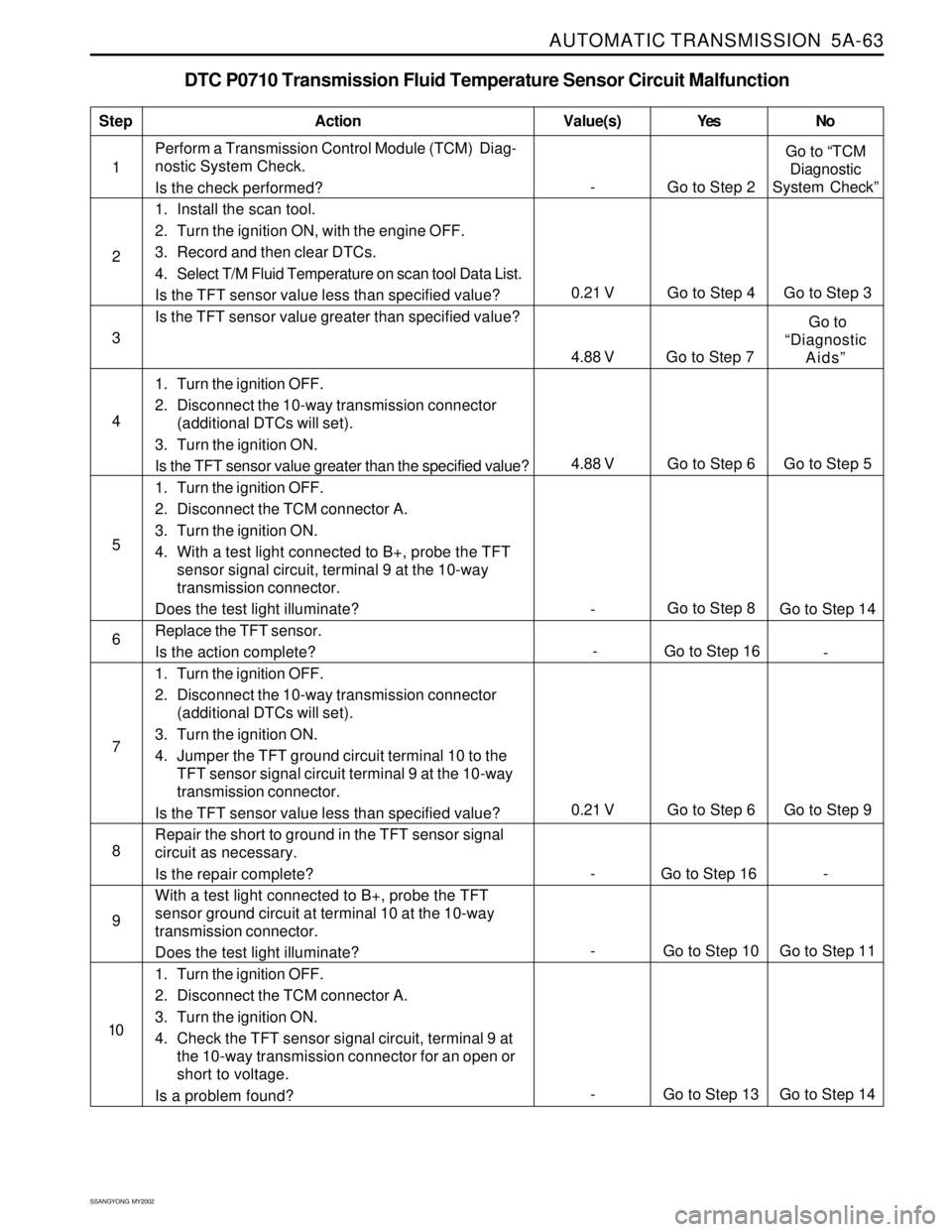
AUTOMATIC TRANSMISSION 5A-63
SSANGYONG MY2002
DTC P0710 Transmission Fluid Temperature Sensor Circuit Malfunction
1Perform a Transmission Control Module (TCM) Diag-
nostic System Check.
Is the check performed?
1. Install the scan tool.
2. Turn the ignition ON, with the engine OFF.
3. Record and then clear DTCs.
4. Select T/M Fluid Temperature on scan tool Data List.
Is the TFT sensor value less than specified value?
Is the TFT sensor value greater than specified value?
1. Turn the ignition OFF.
2. Disconnect the 10-way transmission connector
(additional DTCs will set).
3. Turn the ignition ON.
Is the TFT sensor value greater than the specified value?
1. Turn the ignition OFF.
2. Disconnect the TCM connector A.
3. Turn the ignition ON.
4. With a test light connected to B+, probe the TFT
sensor signal circuit, terminal 9 at the 10-way
transmission connector.
Does the test light illuminate?
Replace the TFT sensor.
Is the action complete?
1. Turn the ignition OFF.
2. Disconnect the 10-way transmission connector
(additional DTCs will set).
3. Turn the ignition ON.
4. Jumper the TFT ground circuit terminal 10 to the
TFT sensor signal circuit terminal 9 at the 10-way
transmission connector.
Is the TFT sensor value less than specified value?
Repair the short to ground in the TFT sensor signal
circuit as necessary.
Is the repair complete?
With a test light connected to B+, probe the TFT
sensor ground circuit at terminal 10 at the 10-way
transmission connector.
Does the test light illuminate?
1. Turn the ignition OFF.
2. Disconnect the TCM connector A.
3. Turn the ignition ON.
4. Check the TFT sensor signal circuit, terminal 9 at
the 10-way transmission connector for an open or
short to voltage.
Is a problem found?
StepAction Value(s) Yes No
2
3
- Go to Step 8
Go to Step 14 5
- Go to Step 16
- 6 4
7
0.21 V Go to Step 6 Go to Step 9
8
9
- Go to Step 2Go to “TCM
Diagnostic
System Check”
0.21 V Go to Step 4 Go to Step 3
4.88 V Go to Step 7 Go to
“Diagnostic
Aids”
10
- Go to Step 13 Go to Step 14
- Go to Step 10 Go to Step 11
- Go to Step 16 -
4.88 V Go to Step 6 Go to Step 5
Page 1159 of 2053
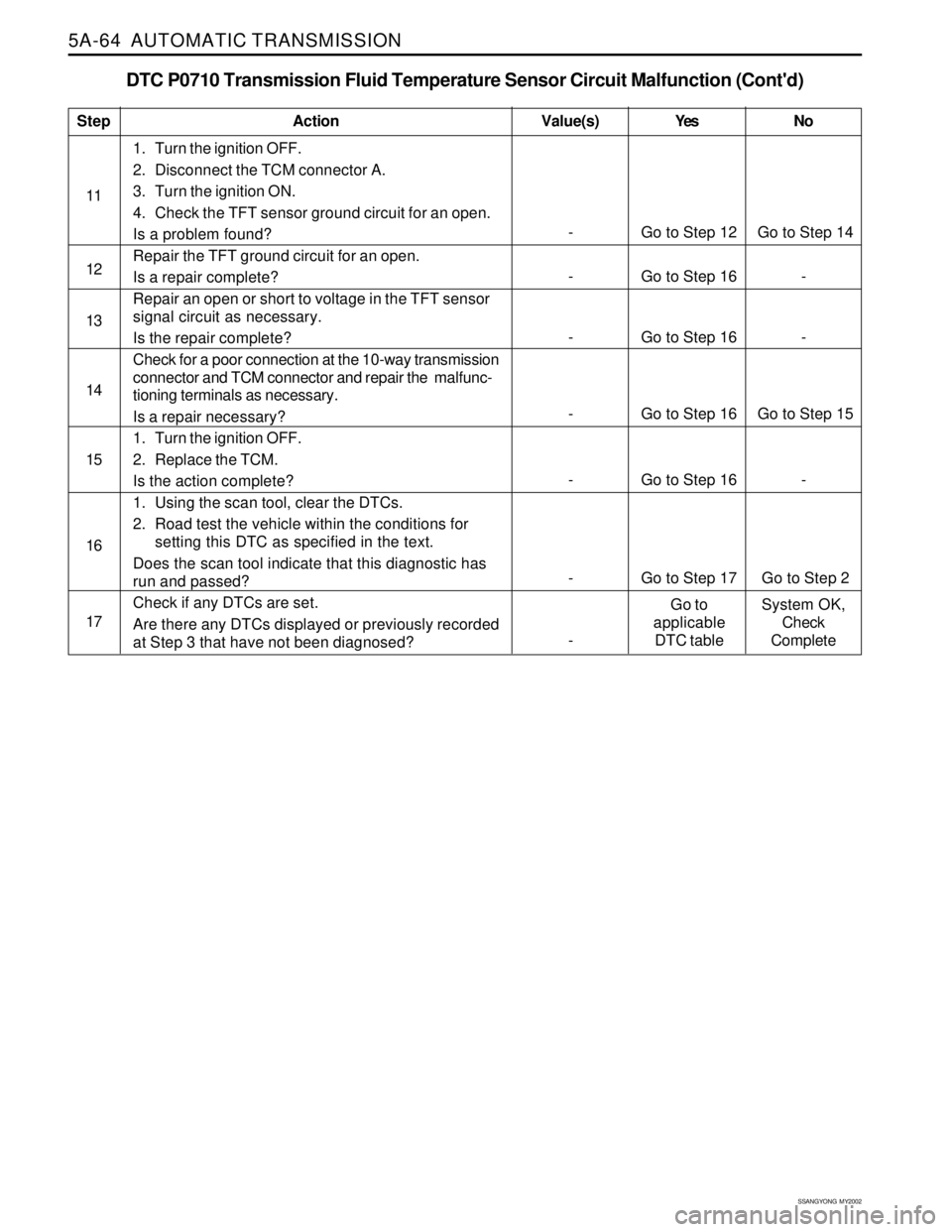
5A-64 AUTOMATIC TRANSMISSION
SSANGYONG MY2002
DTC P0710 Transmission Fluid Temperature Sensor Circuit Malfunction (Cont'd)
1. Turn the ignition OFF.
2. Disconnect the TCM connector A.
3. Turn the ignition ON.
4. Check the TFT sensor ground circuit for an open.
Is a problem found?
Repair the TFT ground circuit for an open.
Is a repair complete?
Repair an open or short to voltage in the TFT sensor
signal circuit as necessary.
Is the repair complete?
Check for a poor connection at the 10-way transmission
connector and TCM connector and repair the malfunc-
tioning terminals as necessary.
Is a repair necessary?
1. Turn the ignition OFF.
2. Replace the TCM.
Is the action complete?
1. Using the scan tool, clear the DTCs.
2. Road test the vehicle within the conditions for
setting this DTC as specified in the text.
Does the scan tool indicate that this diagnostic has
run and passed?
Check if any DTCs are set.
Are there any DTCs displayed or previously recorded
at Step 3 that have not been diagnosed?
StepAction Value(s) Yes No
11
12
- Go to Step 12 Go to Step 14
14
- Go to Step 16 -
15 13
- Go to Step 16 -
16
- Go to Step 16 Go to Step 15
17
- Go to Step 16 -
- Go to Step 17 Go to Step 2
-Go to
applicable
DTC tableSystem OK,
Check
Complete
Page 1197 of 2053
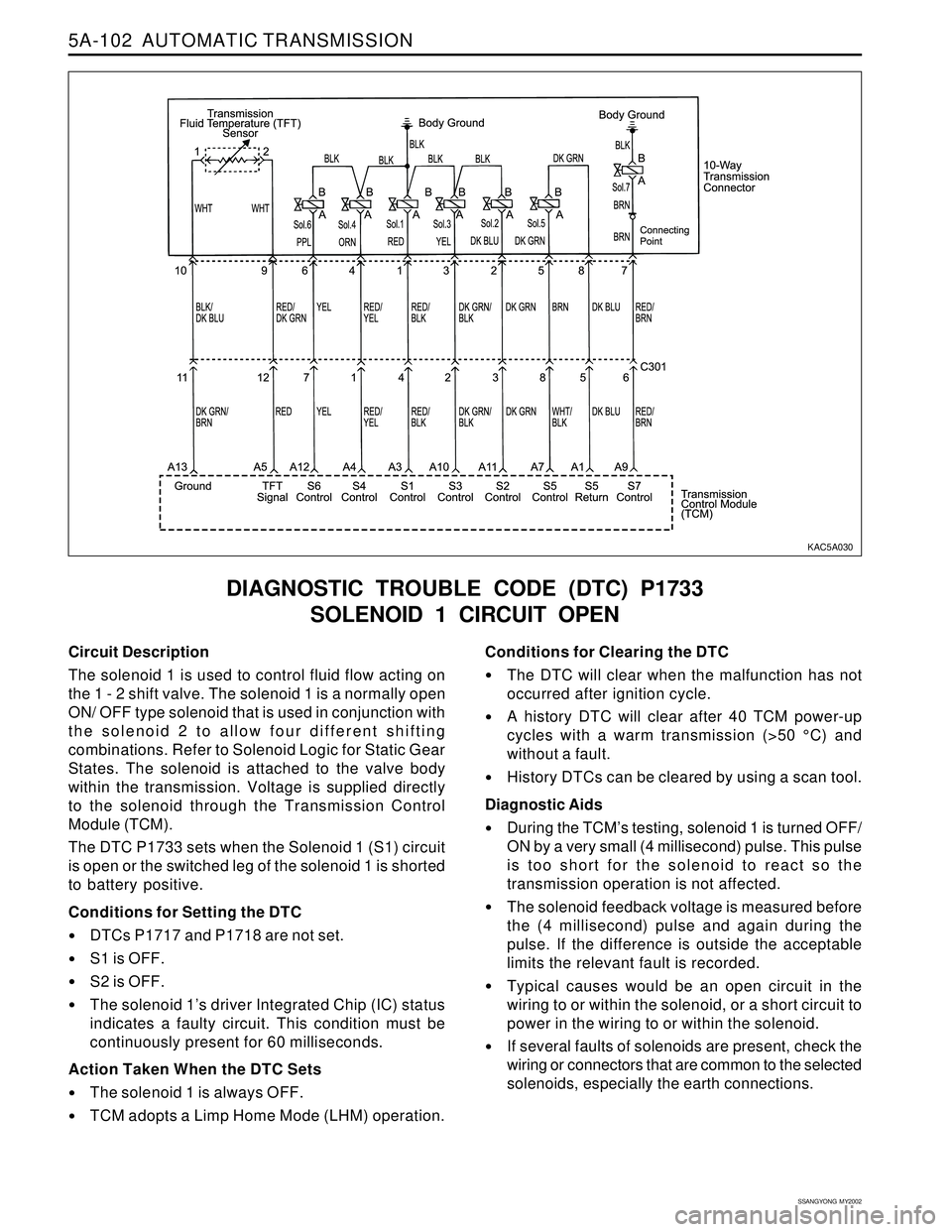
5A-102 AUTOMATIC TRANSMISSION
SSANGYONG MY2002
Circuit Description
The solenoid 1 is used to control fluid flow acting on
the 1 - 2 shift valve. The solenoid 1 is a normally open
ON/ OFF type solenoid that is used in conjunction with
the solenoid 2 to allow four different shifting
combinations. Refer to Solenoid Logic for Static Gear
States. The solenoid is attached to the valve body
within the transmission. Voltage is supplied directly
to the solenoid through the Transmission Control
Module (TCM).
The DTC P1733 sets when the Solenoid 1 (S1) circuit
is open or the switched leg of the solenoid 1 is shorted
to battery positive.
Conditions for Setting the DTC
DTCs P1717 and P1718 are not set.
S1 is OFF.
S2 is OFF.
The solenoid 1’s driver Integrated Chip (IC) status
indicates a faulty circuit. This condition must be
continuously present for 60 milliseconds.
Action Taken When the DTC Sets
The solenoid 1 is always OFF.
TCM adopts a Limp Home Mode (LHM) operation.
DIAGNOSTIC TROUBLE CODE (DTC) P1733
SOLENOID 1 CIRCUIT OPEN
Conditions for Clearing the DTC
The DTC will clear when the malfunction has not
occurred after ignition cycle.
A history DTC will clear after 40 TCM power-up
cycles with a warm transmission (>50 °C) and
without a fault.
History DTCs can be cleared by using a scan tool.
Diagnostic Aids
During the TCM’s testing, solenoid 1 is turned OFF/
ON by a very small (4 millisecond) pulse. This pulse
is too short for the solenoid to react so the
transmission operation is not affected.
The solenoid feedback voltage is measured before
the (4 millisecond) pulse and again during the
pulse. If the difference is outside the acceptable
limits the relevant fault is recorded.
Typical causes would be an open circuit in the
wiring to or within the solenoid, or a short circuit to
power in the wiring to or within the solenoid.
If several faults of solenoids are present, check the
wiring or connectors that are common to the selected
solenoids, especially the earth connections.
KAC5A030
Page 1201 of 2053
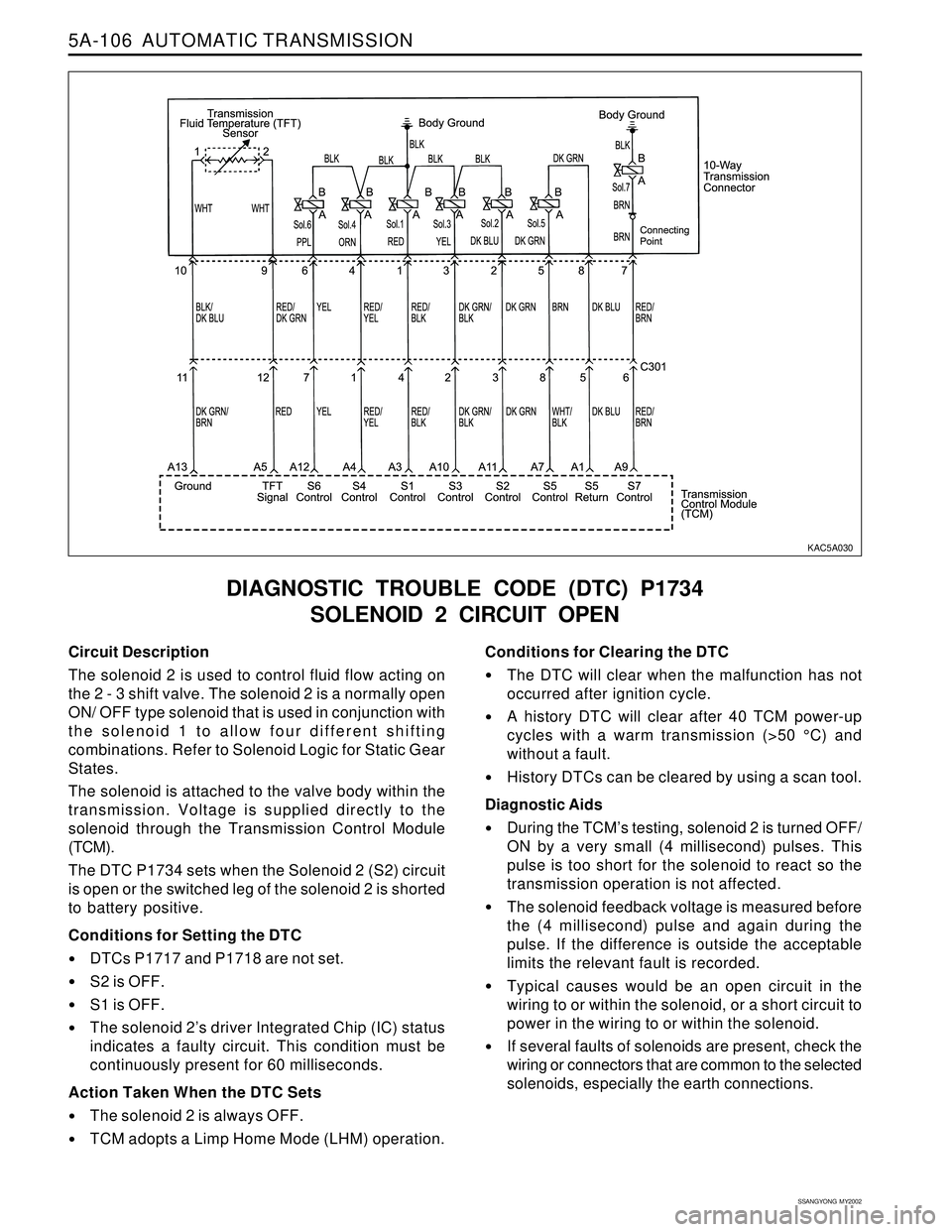
5A-106 AUTOMATIC TRANSMISSION
SSANGYONG MY2002
Circuit Description
The solenoid 2 is used to control fluid flow acting on
the 2 - 3 shift valve. The solenoid 2 is a normally open
ON/ OFF type solenoid that is used in conjunction with
the solenoid 1 to allow four different shifting
combinations. Refer to Solenoid Logic for Static Gear
States.
The solenoid is attached to the valve body within the
transmission. Voltage is supplied directly to the
solenoid through the Transmission Control Module
(TCM).
The DTC P1734 sets when the Solenoid 2 (S2) circuit
is open or the switched leg of the solenoid 2 is shorted
to battery positive.
Conditions for Setting the DTC
DTCs P1717 and P1718 are not set.
S2 is OFF.
S1 is OFF.
The solenoid 2’s driver Integrated Chip (IC) status
indicates a faulty circuit. This condition must be
continuously present for 60 milliseconds.
Action Taken When the DTC Sets
The solenoid 2 is always OFF.
TCM adopts a Limp Home Mode (LHM) operation.
DIAGNOSTIC TROUBLE CODE (DTC) P1734
SOLENOID 2 CIRCUIT OPEN
Conditions for Clearing the DTC
The DTC will clear when the malfunction has not
occurred after ignition cycle.
A history DTC will clear after 40 TCM power-up
cycles with a warm transmission (>50 °C) and
without a fault.
History DTCs can be cleared by using a scan tool.
Diagnostic Aids
During the TCM’s testing, solenoid 2 is turned OFF/
ON by a very small (4 millisecond) pulses. This
pulse is too short for the solenoid to react so the
transmission operation is not affected.
The solenoid feedback voltage is measured before
the (4 millisecond) pulse and again during the
pulse. If the difference is outside the acceptable
limits the relevant fault is recorded.
Typical causes would be an open circuit in the
wiring to or within the solenoid, or a short circuit to
power in the wiring to or within the solenoid.
If several faults of solenoids are present, check the
wiring or connectors that are common to the selected
solenoids, especially the earth connections.
KAC5A030
Page 1225 of 2053
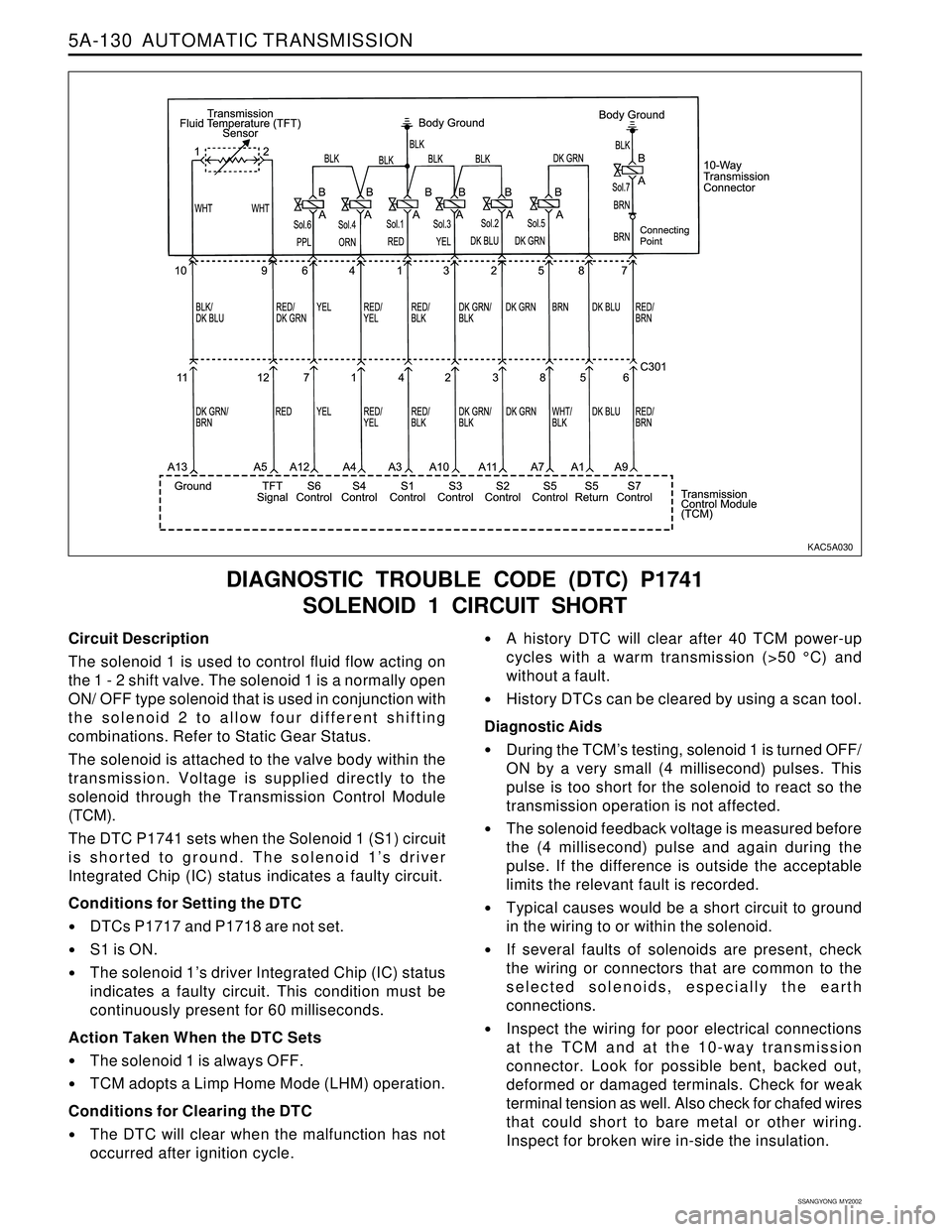
5A-130 AUTOMATIC TRANSMISSION
SSANGYONG MY2002
Circuit Description
The solenoid 1 is used to control fluid flow acting on
the 1 - 2 shift valve. The solenoid 1 is a normally open
ON/ OFF type solenoid that is used in conjunction with
the solenoid 2 to allow four different shifting
combinations. Refer to Static Gear Status.
The solenoid is attached to the valve body within the
transmission. Voltage is supplied directly to the
solenoid through the Transmission Control Module
(TCM).
The DTC P1741 sets when the Solenoid 1 (S1) circuit
is shorted to ground. The solenoid 1’s driver
Integrated Chip (IC) status indicates a faulty circuit.
Conditions for Setting the DTC
DTCs P1717 and P1718 are not set.
S1 is ON.
The solenoid 1’s driver Integrated Chip (IC) status
indicates a faulty circuit. This condition must be
continuously present for 60 milliseconds.
Action Taken When the DTC Sets
The solenoid 1 is always OFF.
TCM adopts a Limp Home Mode (LHM) operation.
Conditions for Clearing the DTC
The DTC will clear when the malfunction has not
occurred after ignition cycle.
DIAGNOSTIC TROUBLE CODE (DTC) P1741
SOLENOID 1 CIRCUIT SHORT
A history DTC will clear after 40 TCM power-up
cycles with a warm transmission (>50 °C) and
without a fault.
History DTCs can be cleared by using a scan tool.
Diagnostic Aids
During the TCM’s testing, solenoid 1 is turned OFF/
ON by a very small (4 millisecond) pulses. This
pulse is too short for the solenoid to react so the
transmission operation is not affected.
The solenoid feedback voltage is measured before
the (4 millisecond) pulse and again during the
pulse. If the difference is outside the acceptable
limits the relevant fault is recorded.
Typical causes would be a short circuit to ground
in the wiring to or within the solenoid.
If several faults of solenoids are present, check
the wiring or connectors that are common to the
selected solenoids, especially the earth
connections.
Inspect the wiring for poor electrical connections
at the TCM and at the 10-way transmission
connector. Look for possible bent, backed out,
deformed or damaged terminals. Check for weak
terminal tension as well. Also check for chafed wires
that could short to bare metal or other wiring.
Inspect for broken wire in-side the insulation.
KAC5A030
Page 1229 of 2053
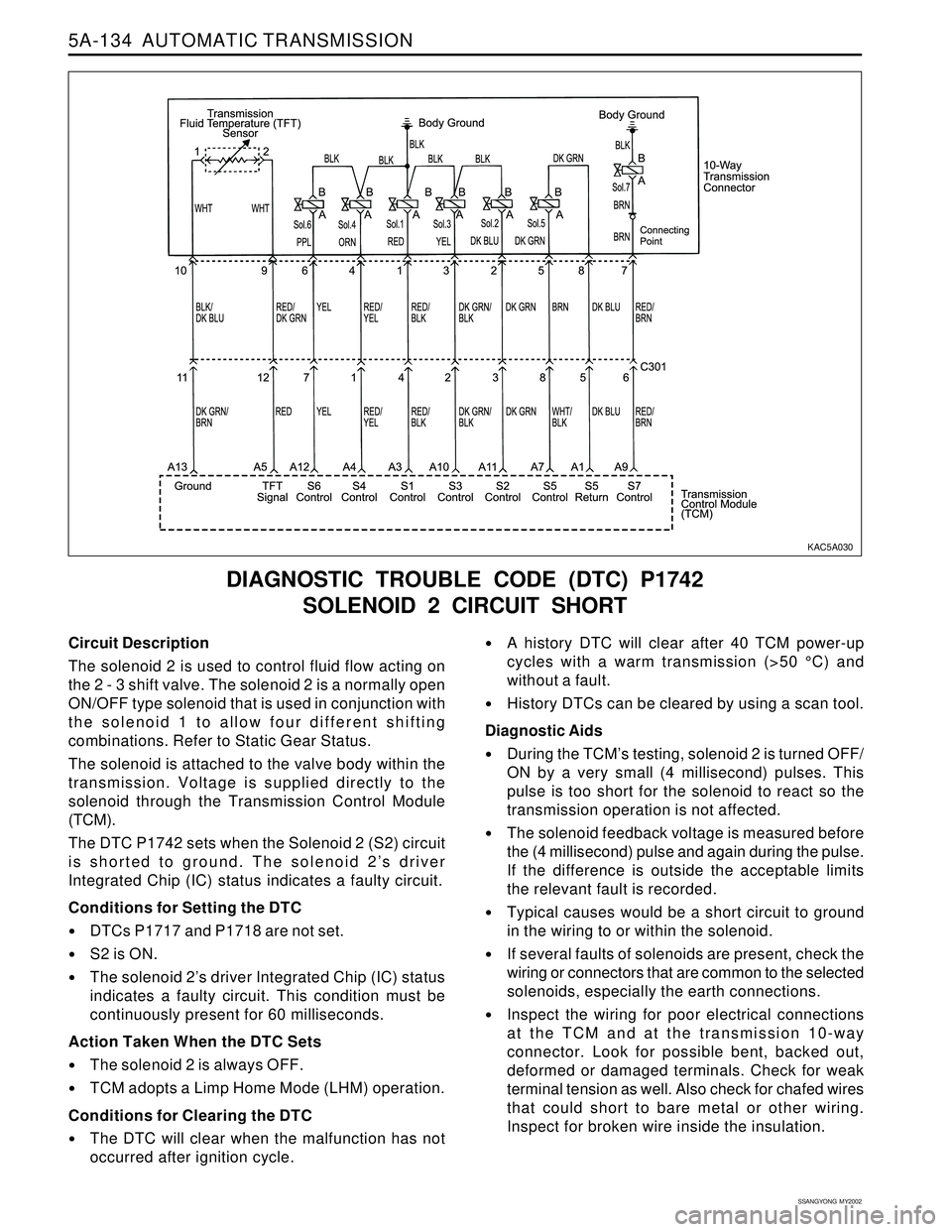
5A-134 AUTOMATIC TRANSMISSION
SSANGYONG MY2002
Circuit Description
The solenoid 2 is used to control fluid flow acting on
the 2 - 3 shift valve. The solenoid 2 is a normally open
ON/OFF type solenoid that is used in conjunction with
the solenoid 1 to allow four different shifting
combinations. Refer to Static Gear Status.
The solenoid is attached to the valve body within the
transmission. Voltage is supplied directly to the
solenoid through the Transmission Control Module
(TCM).
The DTC P1742 sets when the Solenoid 2 (S2) circuit
is shorted to ground. The solenoid 2’s driver
Integrated Chip (IC) status indicates a faulty circuit.
Conditions for Setting the DTC
DTCs P1717 and P1718 are not set.
S2 is ON.
The solenoid 2’s driver Integrated Chip (IC) status
indicates a faulty circuit. This condition must be
continuously present for 60 milliseconds.
Action Taken When the DTC Sets
The solenoid 2 is always OFF.
TCM adopts a Limp Home Mode (LHM) operation.
Conditions for Clearing the DTC
The DTC will clear when the malfunction has not
occurred after ignition cycle.
DIAGNOSTIC TROUBLE CODE (DTC) P1742
SOLENOID 2 CIRCUIT SHORT
A history DTC will clear after 40 TCM power-up
cycles with a warm transmission (>50 °C) and
without a fault.
History DTCs can be cleared by using a scan tool.
Diagnostic Aids
During the TCM’s testing, solenoid 2 is turned OFF/
ON by a very small (4 millisecond) pulses. This
pulse is too short for the solenoid to react so the
transmission operation is not affected.
The solenoid feedback voltage is measured before
the (4 millisecond) pulse and again during the pulse.
If the difference is outside the acceptable limits
the relevant fault is recorded.
Typical causes would be a short circuit to ground
in the wiring to or within the solenoid.
If several faults of solenoids are present, check the
wiring or connectors that are common to the selected
solenoids, especially the earth connections.
Inspect the wiring for poor electrical connections
at the TCM and at the transmission 10-way
connector. Look for possible bent, backed out,
deformed or damaged terminals. Check for weak
terminal tension as well. Also check for chafed wires
that could short to bare metal or other wiring.
Inspect for broken wire inside the insulation.
KAC5A030
Page 1255 of 2053
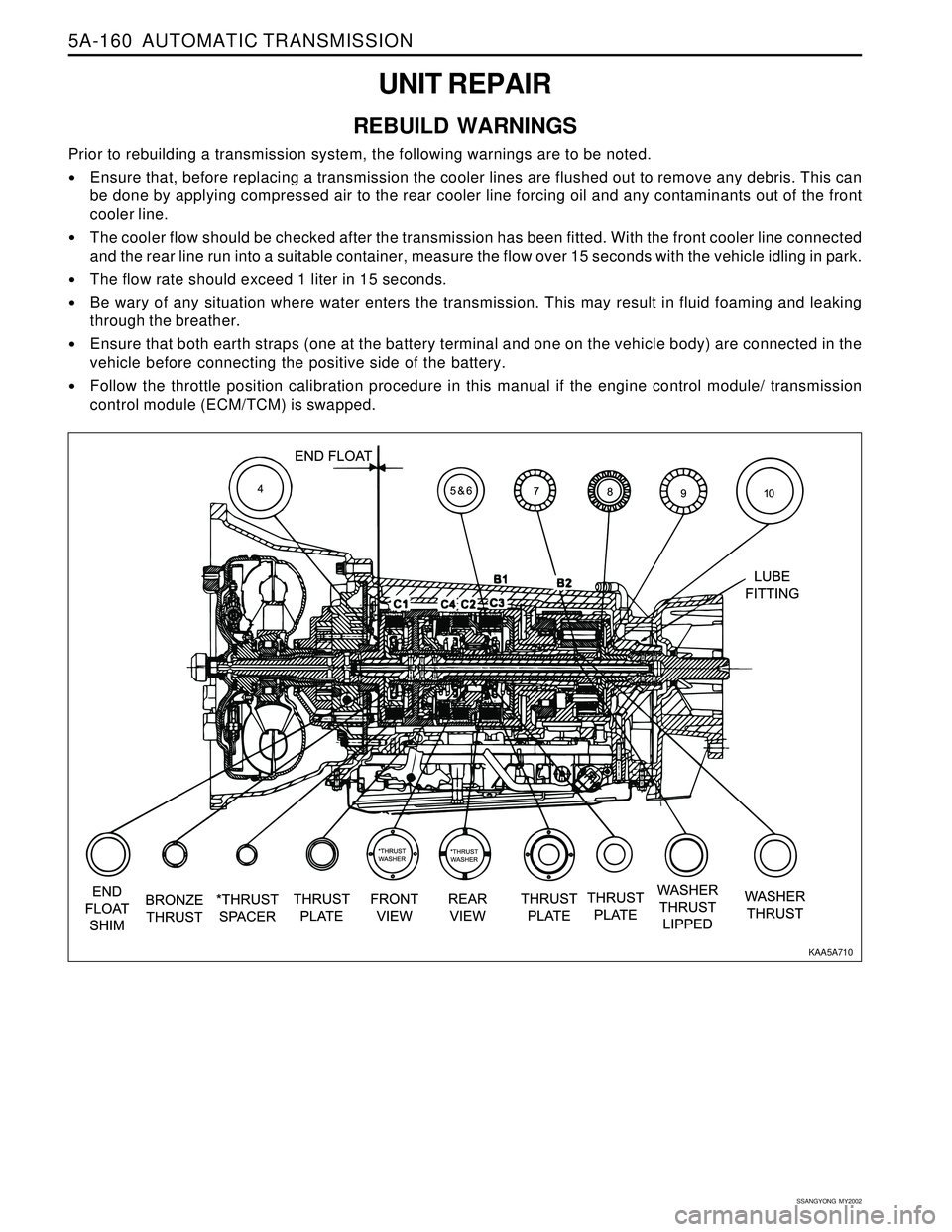
5A-160 AUTOMATIC TRANSMISSION
SSANGYONG MY2002
UNIT REPAIR
REBUILD WARNINGS
Prior to rebuilding a transmission system, the following warnings are to be noted.
Ensure that, before replacing a transmission the cooler lines are flushed out to remove any debris. This can
be done by applying compressed air to the rear cooler line forcing oil and any contaminants out of the front
cooler line.
The cooler flow should be checked after the transmission has been fitted. With the front cooler line connected
and the rear line run into a suitable container, measure the flow over 15 seconds with the vehicle idling in park.
The flow rate should exceed 1 liter in 15 seconds.
Be wary of any situation where water enters the transmission. This may result in fluid foaming and leaking
through the breather.
Ensure that both earth straps (one at the battery terminal and one on the vehicle body) are connected in the
vehicle before connecting the positive side of the battery.
Follow the throttle position calibration procedure in this manual if the engine control module/ transmission
control module (ECM/TCM) is swapped.
KAA5A710